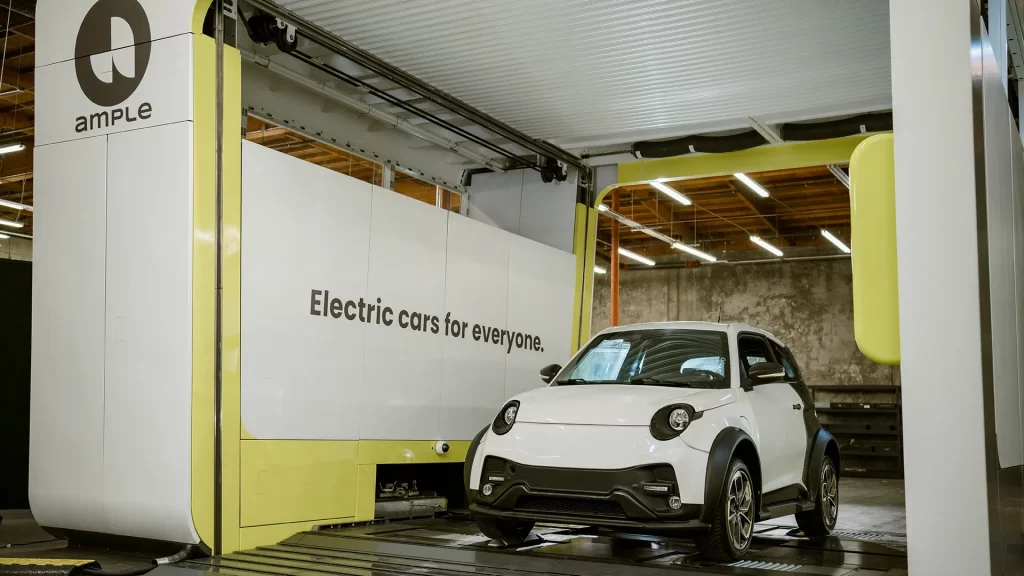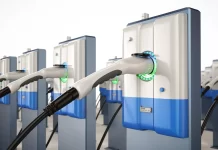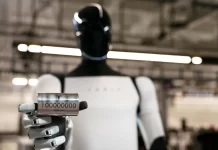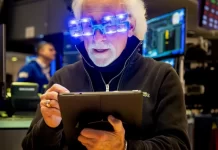
Charging an electric vehicle (EV) is a time-consuming burden — which is why the notion of battery swapping, dismissed by Tesla CEO Elon Musk and many others as unworkable, is still percolating.
Why it matters: Many drivers won’t embrace EVs unless the refueling experience is as seamless as filling up a gas tank.
Driving the news: Ample, a California startup dedicated to battery swapping, is introducing a new streamlined station that cuts the process in half, to about five minutes.
- That’s about the time it takes to fill up a gas tank — and far less than the 30 minutes or more it takes to recharge most EVs at public fast-chargers.
Details: Ample’s pre-fab stations can be deployed across a city in a matter of days. By installing multiple bays at a location, it can accommodate several cars at once.
- Ample has been experimenting with battery swaps for Uber drivers in San Francisco, and recently expanded to Spain and Japan.
- It also just signed a deal with EV maker Fisker to install its swappable batteries in the automaker’s upcoming Ocean SUV.
- Ample will initially target commercial operators, including ride-hailing and delivery vehicles, co-founder and CEO Khaled Hassounah tells Axios.
How it works: Ample makes modular battery packs that can be integrated into EVs of any size and swapped out when depleted.
- The shoebox-size modules fit within an adaptor plate designed to match the shape and size of a given vehicle’s original battery.
- That flexibility means car manufacturers like Fisker can install a swappable Ample battery as an option at the factory.
When a vehicle approaches Ample’s drive-through station, the bay door opens automatically.
- Once parked inside, the driver initiates the battery swap using the Ample app.
- The automated system identifies the vehicle’s battery requirements and swaps the depleted battery pack with a fully charged replacement.
Flashback: Battery swapping has been tried before, with little success.
- In the mid-2000s, Israeli entrepreneur Shai Agassi raised $900 million for a battery swap company called Better Place, which later folded.
- In 2014, Tesla opened a single battery swap station in California, and then abandoned the idea in favor of expanding its Supercharger network.
The problem: EV batteries are cumbersome and there’s no industry standard design.
- Each battery is built specifically for integration within a given car’s unique architecture. They’re not plug-and-play like the AA or AAA batteries in flashlights.
- It’s impractical for each swapping station to store and service many different sizes and types of batteries, says Sam Abuelsamid, principal e-mobility analyst at Guidehouse Insights. “That gets really expensive, really fast.”
- Ample’s modular design is meant to account for these issues.
Meanwhile: One fast-growing Chinese EV company, NIO, is using a standard battery in all six of its models.
- Similar to Tesla’s Supercharger network, its swapping stations are proprietary, open only to NIO customers.
- 60% of NIO’s 320,000 owners have opted to use one of its 1,383 Power Swap Stations in China and Europe, the company recently revealed.
The intrigue: NIO is adding about 1,000 more stations in China and up to 70 more in Europe this year to support what it calls “battery-as-a-service.”
- Under this model, buyers pay separately for the vehicle and the battery — making EV ownership more affordable for those willing to sign up for a monthly battery subscription.
- In Norway, approximately 95% of users have opted for battery-as-a-service, NIO said.
The bottom line: Anything that makes EVs cheaper and refueling easier — whether it’s battery swapping or more accessible charging — could help spur EV adoption.


























